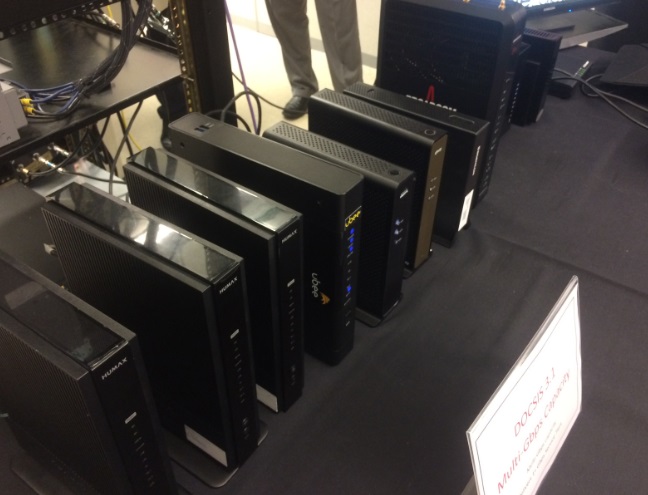DOCSIS 3.1 Gets ‘Real’

Louisville, Colo. -- CableLabs held court at its headquarters here Monday to show that DOCSIS 3.1, cable’s multi-gigabit platform for HFC networks, is ready to go as operators prepare to test and trial the platform.
DOCSIS 3.1 is “real, it’s here today, and it’s delivering what we promised,” declared Belal Hamzeh, director of network technologies for CableLabs, following a string of product demonstrations that featured a mix of more than 20 suppliers of cable modems, cable modem termination systems and test and measurement gear (see full list below).
CableLabs recently announced that it had “opened the door” to vendors that are seeking to certify and qualify products for DOCSIS 3.1. In preparation, CableLabs has been conducting product interops (its sixth D3.1 interop is underway), and has been holding a number of “dry runs” to help vendors prepare for official testing and accelerate their way across the finish line.
CableLabs doesn’t announce when specific products are in for testing, but “once the first devices finish [certification] you’ll hear that loud and clear,” Matt Schmitt, vice president of lab services at CableLabs, said.
In the meantime, operators such as Comcast and Liberty Global are starting to push ahead on D3.1 trials ahead of expected aggressive deployemnts.
DOCSIS 3.1 “is working as advertised,” Tony Werner, Comcast Cable’s EVP and CTO, told reporters.
While DOCSIS 3.1 is expected to be between 25% to 50% more efficient than DOCSIS 3.0 from a bandwidth efficiency standpoint, it’s steering toward the higher end of that range, he said.
Multichannel Newsletter
The smarter way to stay on top of the multichannel video marketplace. Sign up below.
“I lose sleep over a lot of things, but I don’t lose sleep over this,” Werner said of DOCSIS 3.1. In addition to the capacity boost it provides, Werner also talked up other advantages the platform will provide, including advanced diagnostics, improved responsiveness and full spectrum visibility.
While CMTS and cable vendors were out in force at the demos, so were test and measurement vendors such as Viavi that have adapted their platforms for DOCSIS 3.1 or have new ones in the works.
Trilithic, for example, has developed a firmware update for its existing meters that will enable operators to troubleshoot and validate their early deployments of DOCSIS 3.1, and plans to follow with new hardware that’s optimized for D3.1.
ComSonics, meanwhile, has also developed firmware to help MSOs protect against leakage of OFDM-based signals that are well-known in the wireless world but will be new to cable when they deploy D3.1.
An official with Keysight Technologies echoed that signal analyzers for OFDM have been around for a while, but D3.1 presents an “interesting and fun challenge” because of the platform’s higher bit densities.
Some vendors also showed some future looks at the technology. Huawei, for example, demonstrated 16K QAM (16384 QAM) running on a spectral analyzer from Rohde and Schwarz that was touted to be 75% more efficient than DOCSIS 3.0. By comparison, DOCSIS 3.1 operating at 4096 QAM is 50% more efficient than D3.0 running at 256 QAM.
Jack Moran, senior director of cable access networks for Huawei’s wireline access laboratory, called 16K QAM the “wave of the future.” Others agreed, but one engineer cautioned that a move to 16K QAM would require a “major upgrade of the network.”
Here’s a list of CCAP, modem, chipset and test and measurement vendors that took part in Monday’s demos:
-Arris (CPE and CCAPs)
-Askey (CPE)
-Averna (test and measurement)
-Broadcom (silicon)
-Casa Systems (CCAPs)
-Castlenet (CPE)
- Cisco Systems (CCAPs and CPE)
-ComSonics (T&M)
-Excentis (T&M)
-Futurewei/Huawei (CCAPs)
-Humax (CPE)
-Intel (silicon)
-Keysight Technologies (T&M)
-Netgear (CPE)
-Pace (CPE)
-Rohde and Schwarz (T&M)
-Sagemcom (CPE)
-STMicroelectronics (silicon)
-Technicolor (CPE)
-Trilithic (T&M)
-Ubee (CPE)
-Viavi (T&M)
